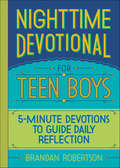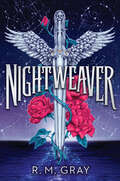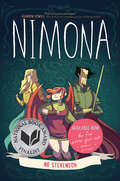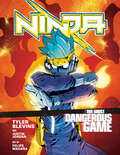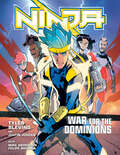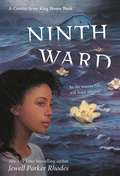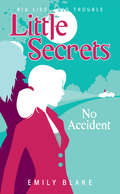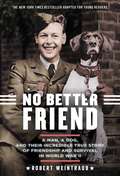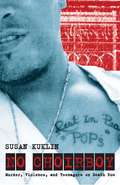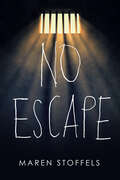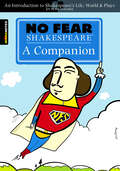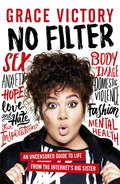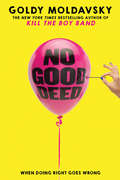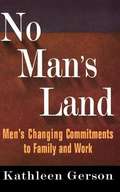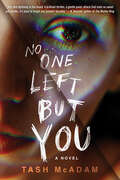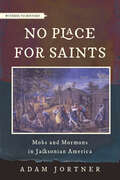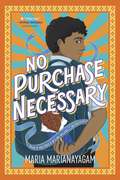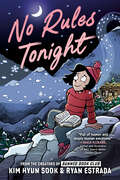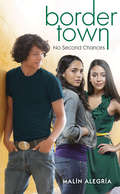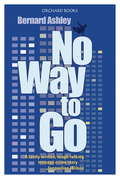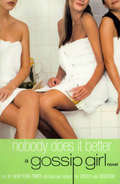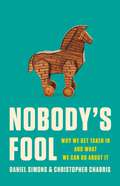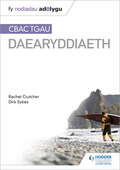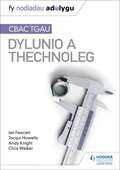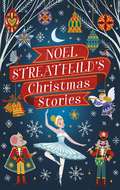- Table View
- List View
Nighttime Devotional for Teen Boys: 5-Minute Devotions to Guide Daily Reflection
by Brandan RobertsonEncourage your teen to end his day with God's wisdomEvery day comes with new challenges, but God is always there to give young men the strength they need to persevere and realize their potential. This boys' devotional provides teens an opportunity to end their day the right way—reflecting on God's love and the lessons that His Word can teach.Go beyond other devotionals for teen boys and help them:Create an evening ritual—Your teen will see how easy it is to make time for God every day with 5-minute devotions they can fit into any nighttime routine.Explore God's wisdom—They'll learn how the Lord's Word can help them with the challenges they'll face with school, friends, relationships, and more.Reflect on their day—With a new devotion for boys every night, this book will help your teen mature with prompts that will encourage him to live up to his potential.Empower your teen to grow into a man of faith with this daily devotional for teen boys.
Nightweaver (Nightweaver)
by R. M. GrayFor fans of Adalyn Grace's Belladonna and Lauren Roberts&’s Powerless, Nightweaver is a propulsive YA fantasy debut about a strong-willed heroine avenging her brother and discovering her destiny. Six hundred years ago, Nightweavers, cursed beings with untamed power, claimed the continents for their own. The ocean was meant to be a safe haven for humanity, including seventeen-year-old Aster Oberon and her pirate family. But after Aster&’s brother is killed in an epic battle at sea against Nightweavers, Aster and her family are thrust into a new life on land. When a handsome Nightweaver named Will offers the Oberons protection and work at his opulent estate, Aster is suspicious. As the arrogant and entitled right hand to the wicked prince, Will is everything that she has been taught to hate. But as he shows empathy and kindness, Aster can&’t ignore a blooming attraction. And even more, Will opens her eyes to a new reality: There are monsters worse than Nightweavers, monsters who may be behind her brother&’s death. As Aster hunts the creatures responsible, dark secrets threaten to unravel everything she once believed about her family, herself, and her world. Filled with elemental magic, forbidden romance, and breathtaking twists, this is a propulsive romantasy about an iron-willed heroine avenging her brother and discovering her destiny—perfect for fans of Powerless and Heartless Hunter.
Nimona: A Netflix Film, A Graphic Novel
by ND StevensonNow a Netflix animated film!Nimona is the New York Times bestselling graphic novel sensation from ND Stevenson, based on his beloved and critically acclaimed web comic. Kirkus says, “If you’re going to read one graphic novel this year, make it this one.”Nemeses! Dragons! Science! Symbolism! All these and more await in this brilliantly subversive, sharply irreverent epic from ND Stevenson. Featuring an exclusive epilogue not seen in the web comic, along with bonus conceptual sketches and revised pages throughout, this gorgeous full-color graphic novel has been hailed by critics and fans alike as the arrival of a “superstar” talent (NPR.org).Nimona is an impulsive young shapeshifter with a knack for villainy. Lord Ballister Blackheart is a villain with a vendetta. As sidekick and supervillain, Nimona and Lord Blackheart are about to wreak some serious havoc. Their mission: prove to the kingdom that Sir Ambrosius Goldenloin and his buddies at the Institution of Law Enforcement and Heroics aren't the heroes everyone thinks they are.But as small acts of mischief escalate into a vicious battle, Lord Blackheart realizes that Nimona's powers are as murky and mysterious as her past. And her unpredictable wild side might be more dangerous than he is willing to admit.Indies Choice Book of the Year * National Book Award Finalist * New York Times Bestseller * New York Times Notable Book * Kirkus Best Book * School Library Journal Best Book * Publishers Weekly Best Book * NPR Best Book * New York Public Library Best Book * Chicago Public Library Best BookFans of ND Stevenson's beloved and bestselling Nimona won't want to miss his moving memoir-in-pictures, The Fire Never Goes Out, featuring short essays, mini-comics, and photographs that span eight eventful years in ND's young adult life.
Ninja: [A Graphic Novel] (Ninja)
by Justin Jordan Tyler "Ninja" BlevinsThe game is real. The stakes are life and death. It&’s on gaming superstar Ninja to save the world in this original graphic novel series! A mysterious video game controller teleports Tyler &“Ninja&” Blevins and other players into a real battle-royale game world. Ninja quickly learns that a power-hungry villain plans to add Earth to his collection of conquered realms. Before doing so, he will force Ninja and the other gamers to fight until only one remains. But he didn&’t count on Ninja fighting back and inspiring others to do the same. Ninja, his trusty sentient headband &“HB,&” and a ragtag team of rebels rise up and take a stand. They&’re not just trying to win a game anymore, they&’re ready to start a revolution.
Ninja: [A Graphic Novel] (Ninja)
by Justin Jordan Tyler "Ninja" BlevinsThe Great Beasts have been unleashed. The war has begun. Gaming superstar Ninja returns in the sequel to the graphic novel Ninja: The Most Dangerous Game!Empowered by the show of resilience from Ninja and his friends in the Ketterung—a broadcasted battle-royale game realm controlled by evil overlord Strigus Thule—the people in all of Thule&’s 1000 Dominions are now rebelling. In response, Thule decides to unleash his Great Beasts, the most powerful victors from previous games, kept to serve as the villainous gamemaster&’s tools for all of eternity. Rather than use their remaining energy to return home at the end of their game, Ninja convinces his friends to stay and help him free the Dominions from Thule&’s tyrannic rule. Will the tenacity, integrity, and camaraderie that kept our hero and his crew alive in the first challenge help them defeat the horrifying Great Beasts—and Strigus Thule himself?
Ninth Ward (Little Brown Novels)
by Jewell Parker RhodesTwelve-year-old Lanesha lives in a tight-knit community in New Orleans' Ninth Ward. She doesn't have a fancy house like her uptown family or lots of friends like the other kids on her street. But what she does have is Mama Ya-Ya, her fiercely loving caretaker, wise in the ways of the world and able to predict the future. So when Mama Ya-Ya's visions show a powerful hurricane--Katrina--fast approaching, it's up to Lanesha to call upon the hope and strength Mama Ya-Ya has given her to help them both survive the storm.Ninth Ward is a deeply emotional story about transformation and a celebration of resilience, friendship, and family--as only love can define it.
No Accident: No Accident (Little Secrets #2)
by Emily BlakeHidden Pasts. Unexpected Beytrayals. Twisted Friendships. Sweet Revenge.The twists keep coming--and no secrets are safe.Kelly let a secret slip, and now she's being blackmailed. Will she pay up...or strike back?Tom must decide where his loyalties lie. How much will he risk to get what he wants?Alison is caught in a dangerous game. When will she make her next move?Zoey just earned herself a new best enemy. Is she up for the fight?Chad knows that appearance is everything. How far will he go to mask the truth?Let the drama begin...
No Better Friend: A Man, a Dog, and Their Incredible True Story of Friendship and Survival in World War II
by Robert WeintraubA middle-grade edition of the New York Times bestselling No Better Friend-the extraordinary tale of friendship and survival in World War IINo Better Friend tells the incredible true story of Frank Williams, a radarman in Britain's Royal Air Force, and Judy, a purebred pointer, who met as prisoners of war during World War II. Judy, who became the war's only official canine POW, was a fiercely loyal dog who sensed danger-warning her fellow prisoners of imminent attacks and, later, protecting them from brutal beatings. Frank and Judy's friendship, an unbreakable bond forged in the worst circumstances, is one of the great recently uncovered stories of World War II. As they discover Frank and Judy's story in this specially adapted text, young readers will also learn about key World War II moments through informative and engaging sidebars, maps, photographs, and a timeline.
No Choirboy: Murder, Violence, and Teenagers on Death Row
by Susan KuklinNo Choirboy takes readers inside America's prisons, and allows inmates sentenced to death as teenagers to speak for themselves. In their own voices--raw and uncensored--they talk about their lives in prison, and share their thoughts and feelings about how they ended up there. Susan Kuklin also gets inside the system, exploring capital punishment itself and the intricacies and inequities of criminal justice in the United States. This is a searing, unforgettable read, and one that could change the way we think about crime and punishment. End items include an excellent glossary, author's notes, further reading list, and organizations with their websites.
No Escape
by Maren StoffelsFollowing the success of her unputdownable debut, Escape Room, Maren Stoffels is back with a new standalone horror novel about a twisted game master who has no intention of letting their players go.&“You have been chosen to participate in a new Escape Room. You can bring one person. The one you trust the most. Your very best friend.&”When Lexi receives an invitation to participate in a brand-new escape room, along with her best friend Tess, she&’s thrilled. They could both use the distraction after a recent tragedy. But once inside, they learn that they must compete against one another.What do you do when your best friend suddenly becomes your biggest adversary, and every choice you make puts her in danger? How far will you go to win?
No Fear Shakespeare: An Introduction to Shakespeare's Life, World & Plays In Plain English (No Fear Shakespeare)
by William Shakespeare SparkNotesLets face it. Hearing people talk about Shakespeare can be pretty annoying. Particularly if you feel like you dont understand him. When people talk about which of Shakespeares plays they like best, or what they thought of so-and-sos performance, they often treat Shakespeare like membership in some exclusive club. If you dont "get" him, if you dont go to see his plays, youre not truly educated or literate. You might be tempted to ask whether the millions of people who say they love Shakespeare actually know what theyre talking about, or are they just sheep? No Fear Shakespeare: A Companion gives you the straight scoop on everything you really need to know about Shakespeare, including: Whats so great about Shakespeare? How did Shakespeare get so smart? Five mysteries of Shakespeares life – and why they matter Did someone else write Shakespeares plays? Where did Shakespeare get his ideas? Shakespeares world Shakespeares theater Shakespeares language The five greatest Shakespeare Characters
No Filter: An Uncensored Guide to Life From the Internet's Big Sister
by Grace VictoryFor fans of BBC Three's Clean Eating's Dirty Secrets and The Cost of Cute, an honest and fun insight into tackling the problems that all young people face.From struggling with an eating disorder and body image issues to flashing Harry Potter (yes, that really did happen), Grace Victory has experienced it all.Here, in No Filter, Grace shares her inspirational story of growing up in a troubled household, battling with depression and finally overcoming it all by learning to love herself just as she is. After years of self-loathing and self-destructive behaviour, she hit an all-time low but thanks to therapy, good friends and an award-winning blog, she has rebuilt herself to become a TV presenter and an inspirational role model for young people. Thanks to her bravery, instinctive honesty and ability to break down taboos, Grace is now able to speak openly about her personal battles and she regularly offers guidance to her legion of fans.Brimming with hilarious anecdotes and no-nonsense advice, the Internet's Big Sister tells you everything you need to know about accepting yourself and fighting back, in style.
No Good Deed
by Goldy MoldavskyFrom New York Times bestselling author Goldy Moldavsky comes an uproarious take on when the best of intentions go horribly wrong.Gregor Maravilla doesn't want much. Just to feed all the starving children. That's why he goes to Camp Save the World, a summer program for teen activists who care about making a difference. What could be better?It's almost perfect. Except some of these causes are kind of...strange. Like Eat Dirt--a campaign started by up-and-coming actress Ashley Woodstone. Gregor wasn't a fan of her work before, and he's certain she's only there now because of her fame. But Gregor is determinged to not let her ruin his experience.And then the contest is announced. That's when the sabotage starts. They want to see who can do the most good. But that leads to the most bad.No good deed goes unpunished.
No Man's Land: Men's Changing Commitments to Family and Work
by Kathleen GersonIn a long-overdue look at the most neglected aspect of the gender revolution--the male side--Gerson, rather than focusing on the differences between men and women, points out the variations among men, and perceives signs of positive change.
No One Left But You
by Tash McAdamA trans teen is swept up in a whirlwind friendship with lethal consequences in this taut YA thriller, for fans of Sadie, Andrew Joseph White, and HBO's Euphoria.BEFORE. Newly out trans guy Max is having a hard time in school. Things have been tough since his summer romance, Danny, turned into his bully. This year, his plan is to keep his head down and graduate. All that changes when new It Girl, Gloss, moves to town. No one understands why perfect, polished Gloss is so interested in an introverted skater kid, but Max blooms in the hothouse of her attention. Caught between romance and obsession, he&’ll do whatever it takes to keep her on his side.AFTER. Haircuts, makeovers, drugs, parties. It&’s all fun and games until someone gets killed at a rager gone terribly wrong. Max refuses to believe that Gloss did it. But if not Gloss, who? Desperate to figure out truth in the wake of tragedy, Max veers dangerously close to being implicated—and his own memories of that awful night are fuzzy. Both sharp-edged thriller and moving coming of age, this gorgeously wrought novel is perfect for readers who want stories with trans characters front and center.
No Place for Saints: Mobs and Mormons in Jacksonian America (Witness to History)
by Adam JortnerThe emergence of the Mormon church is arguably the most radical event in American religious history. How and why did so many Americans flock to this new religion, and why did so many other Americans seek to silence or even destroy that movement?Mormonism exploded across America in 1830, and America exploded right back. By 1834, the new religion had been mocked, harassed, and finally expelled from its new settlements in Missouri. Why did this religion generate such anger? And what do these early conflicts say about our struggles with religious liberty today? In No Place for Saints, the first stand-alone history of the Mormon expulsion from Jackson County and the genesis of Mormonism, Adam Jortner chronicles how Latter-day Saints emerged and spread their faith—and how anti-Mormons tried to stop them. Early on, Jortner explains, anti-Mormonism thrived on gossip, conspiracies, and outright fables about what Mormons were up to. Anti-Mormons came to believe Mormons were a threat to democracy, and anyone who claimed revelation from God was an enemy of the people with no rights to citizenship. By 1833, Jackson County's anti-Mormons demanded all Saints leave the county. When Mormons refused—citing the First Amendment—the anti-Mormons attacked their homes, held their leaders at gunpoint, and performed one of America's most egregious acts of religious cleansing. From the beginnings of Mormonism in the 1820s to their expansion and expulsion in 1834, Jortner discusses many of the most prominent issues and events in Mormon history. He touches on the process of revelation, the relationship between magic and LDS practice, the rise of the priesthood, the questions surrounding Mormonism and African Americans, the internal struggles for leadership of the young church, and how American law shaped this American religion. Throughout, No Place for Saints shows how Mormonism—and the violent backlash against it—fundamentally reshaped the American religious and legal landscape. Ultimately, the book is a story of Jacksonian America, of how democracy can fail religious freedom, and a case study in popular politics as America entered a great age of religion and violence.
No Purchase Necessary
by Maria MarianayagamA funny, poignant MG debut about a boy whose life spirals out of control when he wins a prize in a stolen candy bar.Ajay Anthonipillai has a million-dollar problem.Ajay has lived his life dutifully following the rules set by his Tamil parents. Rules like, “straight A’s only” (rule #3), “no such thing as a no-homework day” (rule #5), and “never watch scary movies” (rules #10). But moving to a new school gives Ajay a new rule to follow: get on seventh grade all-star Jacob Underson’s good side.When Jacob asks him to steal a Mercury bar from Scary Al’s convenience store, Ajay feels this is his chance to finally “get cool” and gain real friends. Maybe even stop eating lunch alone. But Jacob rejects the stolen chocolate bar, leaving Ajay to unwrap it and discover that it contains Mercury’s Twenty-fifth Anniversary Grand Prize: one million dollars!Faced with an extreme dilemma, Ajay will have to bear the weight of his actions and battle his conscience in deciding whether to claim the prize that may change the life of his family forever.Supplemental enhancement PDF accompanies the audiobook.
No Rules Tonight: A Graphic Novel
by Ryan Estrada Kim Hyun SookFrom the creators of Banned Book Club comes a young adult graphic novel about unveiling secrets, confessing your crushes, and finding yourself: all in the mountains of South Korea on Christmas Eve.It's time for the annual winter camp at Anjeon University. A full weekend, deep in the mountains, with no parental supervision. But this is no ordinary getaway. It is 1980s South Korea where the police are always watching and even the slightest bit of self-expression can lead to arrest. Luckily, it's the only night of the year when generations of Koreans had no curfew, no obligations, and no rules: Christmas Eve.In the snowy mountains, everyone has a different plan for their one night of freedom. Hyun Sook is trying to restart her banned book club but has to hide from a boy she suspects of being a spy. Taehee and Kiwoo are trying to build up the nerve to confess their feelings for one another, while Suji pines after her crush, ready to risk it all and finally tell someone the secret she's been hiding for her entire life.Acclaimed creators Kim Hyun Sook and Ryan Estrada deliver a cinematic, hilarious, and heartfelt story about the universality of growing up, making friends, and falling in love.
No Second Chances (Border Town #4)
by Malín AlegríaIn Dos Rios, Texas, things aren't always as they seem.Santiago might be in over his head this time. . . Santiago's grades are slipping again, but he's determined to prove to his family that he can be successful at something, even if it's not school. When a fancy new taco chain moves in across the street from the Garza family restaurant, Santiago is inspired-- he'll open a food business of his own!Unfortunately, running a business is not as much fun as Santiago thought it would be. Fabi and Alexis keep interfering, customers aren't easily won over, and even worse, El Payaso is back in Santiago's life-- and just waiting for him to mess up.
No Way to Go
by Bernard AshleyAmber is shocked when her brother falls to his death from a tower block. She's convinced it wasn't an accident, and so begins her journey to discover the truth and bring some kind of justice for Connor. With twists, turns and a fabulous multi-layered plot, Bernard Ashley has created a thrilling and engrossing tale. Set in south east London, this is a incredibly gritty and absorbing novel.
Nobody Does It Better: A Gossip Girl Novel (Gossip Girl Novel #7)
by Cecily Von ZiegesarThe uptown girls are headed downtown as Serena and Jenny take on their new fabulous roles as rock-star model girlfriends of New York's hottest band, The Raves. Meanwhile, Dan is to busy drowning his sorrows in empty bottles to notice a mysterious French beauty who has a penchant for dirty, Jim Morrison-wannabe lead singers. Blair takes residence at the Plaza to think about her future. Will she become a gun-toting international spy or Manhattan's snobbiest society hostess? Decisions are so difficult! Sounds like everyone needs a day off at the spa. And Senior Spa Day promises to serve up further doses of scandal for New York's busiest private-school vixens.
Nobody's Fool: Why We Get Taken In and What We Can Do about It
by Christopher Chabris Daniel SimonsFrom two New York Times-bestselling psychologists, &“an engaging master class in how to foil purveyors of false promises&” (Philip E. Tetlock, author of Superforecasting) From phishing scams to Ponzi schemes, fraudulent science to fake art, chess cheaters to crypto hucksters, and marketers to magicians, our world brims with deception. In Nobody&’s Fool, psychologists Daniel Simons and Christopher Chabris show us how to avoid being taken in. They describe the key habits of thinking and reasoning that serve us well most of the time but make us vulnerable—like our tendency to accept what we see, stick to our commitments, and overvalue precision and consistency. Each chapter illustrates their new take on the science of deception, describing scams you&’ve never heard of and shedding new light on some you have. Simons and Chabris provide memorable maxims and practical tools you can use to spot deception before it&’s too late. Informative, illuminating, and entertaining, Nobody&’s Fool will protect us from charlatans in all their forms—and delight us along the way.
Nodiadau Adolygu (My Revision Notes: Cbac Tgau Daearyddiaeth (my Revision Notes: Wjec Gcs
by Dirk Sykes Rachel CrutcherExam Board: WJECLevel: GCSESubject: GeographyFirst teaching: September 2016First exams: Summer 2018Target success in WJEC GCSE Geography with this proven formula for effective, structured revision. Key content coverage is combined with exam-style tasks and practical tips to create a revision guide that students can rely on to review, strengthen and test their knowledge.With My Revision Notes every student can:- Plan and manage a successful revision programme using the topic-by-topic planner- Enjoy an active approach to revision with clear topic coverage and related 'Now Test Yourself' tasks and practical revision activities- Improve exam technique through exam tips and formal exam-style questions- Monitor their knowledge and progress using the answers provided for each 'Now Test Yourself' activity and exam-style question- Develop geographical understanding and enhance exam responses with event/place examplesPlease note: This is a Welsh-language edition.
Nodiadau Adolygu: CBAC TGAU Dylunio a Thechnoleg (My Revision Notes:WJEC GCSE Design and Technology Welsh-language edition
by Chris Walker Ian Fawcett Andy Knight Jacqui HowellsTarget success in WJEC GCSE Design and Technology with this proven formula for effective, structured revision. Key content coverage for Engineering Design, Fashion and Textiles and Product Design is combined with exam-style tasks and practical tips to create a revision guide that you can rely on to review, strengthen and test your knowledge.With My Revision Notes you can:- plan and manage a successful revision programme using the topic-by-topic planner- consolidate subject knowledge by working through clear and focused content coverage- test understanding and identify areas for improvement with regular 'Now Test Yourself' tasks and answers- improve exam technique through practice questions, expert tips and examples of typical mistakes to avoid
Noel Streatfeild's Christmas Stories
by Noel Streatfeild'The wonderful Noel Streatfeild's Christmas Stories collects, for the first time, nine festive stories originally written for annuals and magazines in the 1940s and 1950s . . . As ever, Streatfeild's children always feel utterly real and relatable. A beautifully produced treat' Anna Carey, Irish TimesIn this captivating collection of stories by the author of Ballet Shoes, there are auditions on stage and antics on ice, trips to the pantomime, holiday adventures, and laughter shared with family and friends. Charming, heartwarming and funny, this collection will bring joy to readers of all ages.Originally written in 1940s-60s for annuals, magazines and the radio, these stories have never been collected before.With enchanting line drawings by by Peter Bailey.Stories include:The AuditionThe Bells Keep Twelfth NightThe Moss RoseThimbleThe PrincessThe ChainChristmas at CollersThe Pantomime GooseSkating to the Stars
